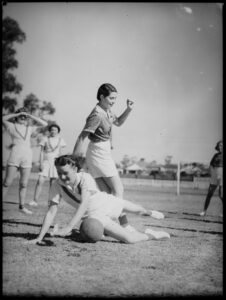Women have played football in Australia for over 100 years. We need to know more about the shoulders we stand on; the women who, in spite of incredible challenges, prejudice and a lack of resources or encouragement, persisted and played.

This short series (see here and here) seeks to map the heritage of Australian women’s football. It connects a dot or two and uncovers some of the rich, hidden and under-appreciated history of the game we love.
There’s enough evidence, even if it is fragmented, in local archives and press articles to suggest significant interest and enthusiastic participation in women’s football across the 1930s.
In the Hunter Region, north of Sydney, a number of teams – Kurri North End, Weston, Abermain, and Speers Point and others – played regular, competitive and exhibition matches for around five years between 1928 and 1933. These matches raised funds for a soup kitchen, a local school, and the northern miners’ relief fund. Sometimes they played in competitions and sometimes for playing’s sake.
The crowd pleasers were well-prepared. Teams trained for weeks in the lead-up to any advertised public match, including those that took place at the Sydney Sports Ground. In 1929, under floodlights, a paying crowd of over 7000 watched Speer’s Point beat Weston Ladies 1–0 for the NSW state title.
Building on momentum gathering in the Hunter Valley, a new governing body, the Women’s Soccer Football Association, formed in Lithgow, New South Wales, in 1931. Local newspaper reports suggest as many as 50 women put their hand up to play.
Two teams formed almost immediately. Ms V. McGuirk, (middle row, right, end) is noted in the image (above) as a trainer. She’d have to be one of Australia’s first female trainers. She may not be, of course. We don’t know enough about the other teams to be sure, but it is a significant observation. (This image was cribbed from a history group on Facebook, the original source is unknown, but we would love a copy if you can find one!)
The Lithgow teams would compete against those already playing in Sydney and the northern coalfields. More teams formed. Local reports suggest weekly football involving at least four teams. Echoing the workplace-based team names in England, the competition west of Sydney, included Zig Zags (possibly the rail workers), State Mine, Vale of Clwydd and at least one, maybe two Blue Bird teams, with their Arnott’s ‘sponsorship’ – Arnott’s may have been the region’s largest employer at the time.
Jessie Laird, the Blue Birds’ captain, (middle, front row, holding the ball) sprained her ankle during a match against Vale of Clwydd on Sunday 23 August 1931 and had to be treated at the ambulance station.
In Ipswich, weekly ‘ladies’ soccer’ meetings were advertised in local newspapers in 1932-33. Teams played in Booval, Ipswich. Another team, Swifts Ladies Soccer Club, formed in Bundamba, Ipswich. Public calls were made for an intercity competition. While the all-male committee of the West Moreton British Football Association went as far as suggesting women’s games would provide excellent curtain raisers for their already-popular men’s competition, their conservative Brisbane counterparts were shutting it down. Those Brisbane residents who petitioned for intercity competition were told that, ‘Football was not a suitable past-time for women’.
There is anecdotal evidence of women’s matches in Broken Hill in 1936 and in Bankstown and in Newcastle in 1938. This article features photographic evidence of a match in 1939 taken by N. Herfort (held by Mitchell Library NSW).
We’re chasing leads now, putting what we know about the 1940s together. If you can help, or can add to any part of the incredible and, up to now, hidden history of our game, we’d love to hear from you.
Follow our history of Australian women’s football.
Guest contributor Lee McGowan is the co-author of Never Say Die.